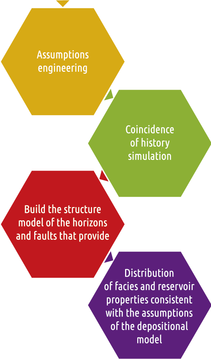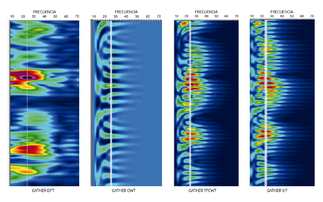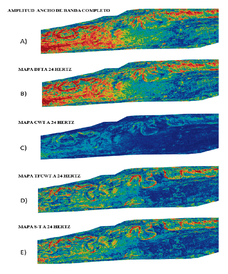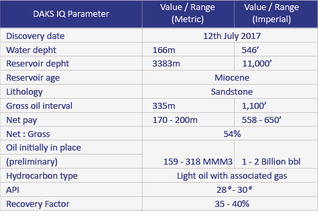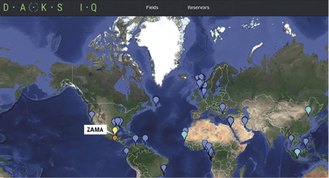Seismic Inversion
To find oil and gas in most plays, it is no longer enough to make conventional reflection seismic interpretation. It is vital to know much more about both the rock and the fluids before drilling.
Net Brains offers the possibility of helping in the interpretation of rock and fluid properties and characterization of deposits for conventional plays in clastics and carbonates, and unconventional plays in shales and tight sands.
An inversion can be made after stacking to derive the relative acoustic impedance and the wide acoustic impedance band respectively. Pre-assembly investments to extract the absolute properties of rock and fluid (log-like).
These advanced techniques improve the evaluation of prospective areas and reservoir characterization, making it possible to obtain oil and gas in the pipeline much earlier and in greater proportion.
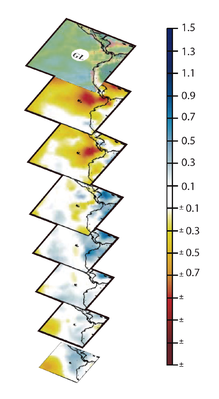
By configuring gathers using seismic that goes through a Bandwidth Extension or bandwidth extension process, we have considerably expanded the scope of this valuable tool to determine the risk when conducting an AVO study.
Reservoirs Characterization
Reservoir Characterization is the model of a specific volume of the subsoil that incorporates all the geological characteristics of the deposit. These models are used to quantify characteristics within the volume of the subsoil that are relatively stable over long periods of time and can therefore be considered static.
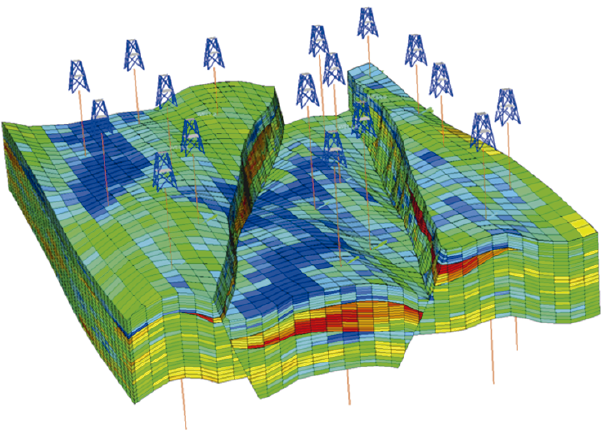
These attributes include the modeling of the structural shape and the thicknesses of the formations within the subsoil volume, together with their lithologies and the porosity and permeability distributions. These last two characteristics often vary significantly from one location to another within the volume, which generates heterogeneity.

However, the porosity and permeability are stable in the almost geological timeframe and do not change due to the movement of fluids or gases through the porous spaces in the formations. The result is a reservoir characterization model (also known as a “static model” and sometimes called a “geological model”).
Figure 1. Workflow "Static Model"
The shale gas reservoir rocks require the analysis of high quality seismic data, cores and log measurements and engineering data to produce a precise reservoir characterization model.
This model is used as input data in reservoir simulation, during which reservoir engineers add other reservoir characteristics, such as pressures, temperatures, and fluid and gas compositions. These characteristics can change due to the movement of fluids or gases through the porous spaces of the formations.
Because they are dynamic by nature in short time frames, once production has started, these models are called “dynamic models.” Detailed reservoir simulations (dynamic models) that are based on accurately developed reservoir characterizations ( static models) can be of great value to optimize the location of the well and the planning of the development of the field.
Figure 2. Workflow "Dynamic Model"
Spectral Decomposition
Higher quality and better definition of geo-bodies, deposit geometries, deposit patterns and sedimentary models. Lateral continuity, thickness of strata, and structural elements. These are some of the advantages that the Spectral Decomposition analysis provides.
This decomposes the seismic signal into its frequency components, which can identify stratigraphic and subtle structural features that may be hidden in data displays with full bandwidth. The method is based on the fact that a thin-layer reflection has a unique spectral response in the frequency domain, and uses a mathematical algorithm that reveals distribution of frequencies.
Spectral Decomposition is a method to process seismic data in different frequency planes. When the Spectral Decomposition algorithm is applied to the seismic reflection data.
The use of different methods of spectral decomposition helps to visualize the morphology of a study area and depending on the choice of method can greatly improve the understanding of the potential of oil deposits associated with the presence of stratigraphic features. Comparing the gathers generated from each method, the differences in frequency resolution between the five techniques are shown
Figure 1. The following figure shows four gathers of frequencies generated from each mathematical algorithm, which are used to generate the results of the spectral decomposition.
The service includes six different types of analysis for spectral decomposition.
Spectral decomposition allows the detection of thin layers and geological features beyond the limits of traditional post-stack seismic analysis.
• Discrete Fourier Transform
• Continuous Wave Transform
• Continuous Waveform Transform Frequency-Time
• Transformed S
• Continuous Waveform Package Transform
• Realistic Seismic Wave Transform
The ColorCube tool allows the creation of high resolution maps based on frequencies. These visual displays make blending of low, medium and high frequencies.
Figure 2. Comparative analyzes of the maps generated with the attribute of Spectral Frequency Decomposition.
ZAMA oil discovery
New discovery insight from analogs / July 19, 2017
Talos Energy and its partners, Premier Oil and Sierra Oil and Gas, announced last week a world-class oil discovery at its Zama prospect, in Block 7, offshore Mexico (see Figure 1). The Zama-1 well is the first offshore exploration well drilled by the private sector in Mexico’s history – a great start for exploration investors in Mexico.
The C&C Reservoirs global knowledge base DAKS IQ has been employed to review the Zama discovery and benchmark the recovery factor and development practices that could enhance the recoverable oil. We used the DAKS IQ proprietary workflow of Capture > Search > Analyze > Insight to provide this brief review.
Figure 1. Location of Zama oil discovery
KNOWLEDGE CAPTURE: By the 17th of July 2017 the following (see Figure 2) has been released on the Zama -1 well:
Figure 2. Table of released Zama-1 parameters
Figure 2 presents an implied recoverable volume of 350 – 800 MMBBL. Does this capture the full range and is there further potential upside? Analogs can help to answer this question.
Figure 3. Map of applicable global reservoir analogs
SEARCH: Using the DAKS IQ classification system, we can quickly locate all global fields with similar lithology, fluid and engineering parameters. These will be the population of applicable global reservoir analogs that can be used for benchmarking and further insight.
The population of applicable global reservoir analogs can be further refined based on the challenge that is being addressed. Proximal analogs rarely provide sufficient information hence a global view is needed. Zama is located in the Salinas Basin (see Figure 3) where the existing discoveries are dominated by the Cantarell complex. These are fractured breccias and as such are not applicable analogs for Zama.
Figure 4. Recovery factor histogram
ANALYSIS: BENCHMARK We note the Zama discovery is in shallow water depths and an initial recovery factor of 40% has been suggested. In these shallow water depths and deploying latest technology, is a higher economic recovery factor possible?
The recovery factor histogram (see Figure 4) from the applicable global reservoir analogs shows that the average re-covery factor achieved is 38%, but the upper range exceeds 60%. More detail on the recovery factor by development scenarios employed and the incremental recovery achieved through the application of improved recovery or enhanced oil recovery techniques can be learned from these analogs.
INSIGHT: We note that the Miocene sandstone play type seen in Zama has numerous global analogs, which show the recovery factor may exceed the originally estimated 40%. For those fields that have exceeded 40%, their reservoir management best practices indicate continuous water injection and horizontal wells have had the greatest impact. Also, a number of the analog reservoirs require sand control or stimulation due to clay plugging. With further geological detail from Zama-1 (e.g. porosity, permeability, clay mineral component, diagenetic history) these considerations could be evaluat-ed in more detail through the further application of analogs (see Figure 5).
Figure 5. Characterization table for improved recovery parameters
For more information on how DAKS IQ can be used for global analog analysis, contact C&C Reservoirs and Net Brains.
Net Brains offers timely, functional and reliable solutions in physical security, which satisfy the requirements of the client in the management of their information and their technological resources, within a framework of continuous improvement of the effectiveness of our quality management system.
Nowadays the Physical Security of the real estate is more than just having CCTV, or security forces; It is necessary to have smarter applications collaborating with each other on a single platform, with which they can obtain statistics, automation, rapid evidence, forensic analysis etc., by Net Brains provides various solutions within the field of Physical Security from the implementation of a single system to the integration of several in a single platform.
© 2025 Net Brains de México





